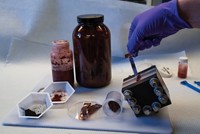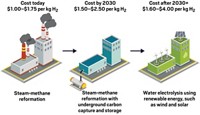Advertisement
Grab your lab coat. Let's get started
Welcome!
Welcome!
Create an account below to get 6 C&EN articles per month, receive newsletters and more - all free.
It seems this is your first time logging in online. Please enter the following information to continue.
As an ACS member you automatically get access to this site. All we need is few more details to create your reading experience.
Not you? Sign in with a different account.
Not you? Sign in with a different account.
ERROR 1
ERROR 1
ERROR 2
ERROR 2
ERROR 2
ERROR 2
ERROR 2
Password and Confirm password must match.
If you have an ACS member number, please enter it here so we can link this account to your membership. (optional)
ERROR 2
ACS values your privacy. By submitting your information, you are gaining access to C&EN and subscribing to our weekly newsletter. We use the information you provide to make your reading experience better, and we will never sell your data to third party members.
Business
Earth-Friendly Chlorine
Technology: Bayer’s new cathode saves energy, reduces greenhouse gas emissions
by Marc S. Reisch
April 5, 2010
| A version of this story appeared in
Volume 88, Issue 14

Bayer MaterialScience plans to build an industrial-scale chlorine unit in Germany using new cathode technology that will reduce energy consumption up to 30% and save as much as 10,000 metric tons of carbon dioxide emissions annually compared with standard membrane technology.
According to Bayer, the 20,000-metric-ton-per-year installation will be the first industrial-scale demonstration of oxygen depolarized cathode (ODC) technology in making chlorine, which is used in a wide variety of industrial chemicals and plastics. The unit will be built at Chempark, in Krefeld-Uerdingen, Germany, where Bayer will further process the chlorine into polyurethane precursors.
The new unit, which will start up in the first half of 2011, will be similar to a traditional chlor-alkali membrane separation plant, says Hans-Joachim Wittig, Bayer’s climate and energy leader. However, the new process substitutes a proprietary cathode in place of a traditional cathode, such as nickel, in the electrolysis of a salt solution.
Use of high-purity oxygen lowers the voltage in the brine cell, Wittig notes, saving electricity and thereby reducing CO2 emissions. The lower voltage, however, also limits output of hydrogen, a valuable by-product.
“It would be a great achievement if they could actually reduce energy consumption by 30%,” Westport, Conn.-based consultant Rick Narang says. Energy costs can account for anywhere from 50 to 75% of the cost of chlorine production. But although the energy cost savings look considerable, says L. Calvert Curlin, a consultant based in Naples, Fla., the loss of by-product hydrogen may make some industrial users think twice before adopting the Bayer technology.
Wittig admits that chlorine makers that use hydrogen to make industrial chemicals might not take on the new process. Capital costs for the cells are also higher than for the more traditional membrane cells, he adds. But given the energy and greenhouse gas savings, he says, the new technology is a worthwhile option for chlorine producers that want to reduce their contribution to climate change.




Join the conversation
Contact the reporter
Submit a Letter to the Editor for publication
Engage with us on Twitter